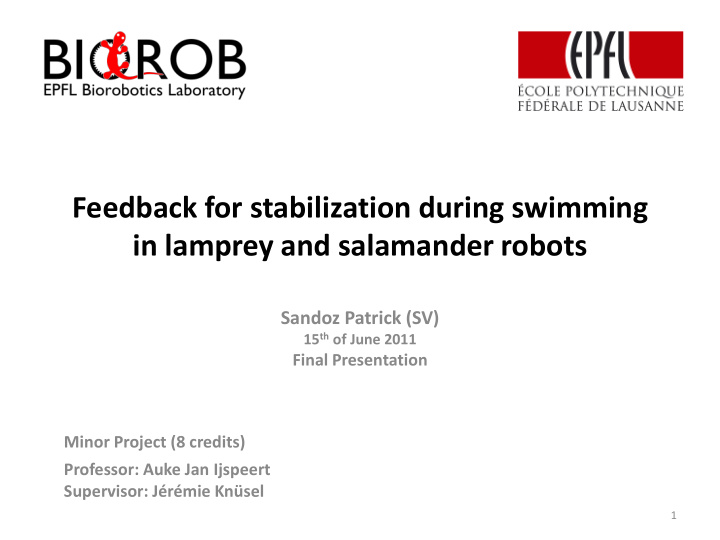



Feedback for stabilization during swimming in lamprey and salamander robots Sandoz Patrick (SV) 15 th of June 2011 Final Presentation Minor Project (8 credits) Professor: Auke Jan Ijspeert Supervisor: Jérémie Knüsel 1
Reminder • Postural stabilization method against rolling and pitch tilt • Bio-inspired response based on the vestibular system from A.K. Kozlov et al., Modelling postural control in the lamprey (2001) • Feedback sensor: 3-Axes Digital Accelerometer (MMA8453Q) 2
Goals • Stabilization during swimming (2 parallel investigations) Test on the robot Profiles Movie Response: generation analysis Simulation in Webots Implement Test and Design the Sensor: into the calibrate model controller/CPG 3
Framework orientation • Investigate postural control methods using the limbs directly on the salamander robot • Test different limb shapes and effects • Perturbation case-sensitive method • Test different swimming gaits • Prepare control experiments • Tests postural control with perturbations 4
Sensor calibration y y z y x z 5
Referential 6
Perturbation cases Stability is defined by gravity sensing on the three axes. Variations on the three axes are necessary to identify the perturbation type 7
Stabilization model Progressive implementation • 1 st into the Controller • Perturbation case-sensitive model for rolling and pitch tilt • 2 nd into the CPG • Perturbation case-sensitive model for rolling and pitch tilt • Reduce oscillation amplitude while correcting • Use oscillation phase of limbs 8
Limbs selection Small ailerons Control (without limbs) 9
Swim guidance I • Dive / surface 10
Swim guidance II • Turn right / left 11
Non-perturbed swimming: controller Ailerons stabilize the swimming (even without postural control method) Globally the adaptive model gives lower differences but not significantly Combined rolling and yaw tilt of the head remains important 12
Front oscillation reduced amplitude Reducing the oscillation amplitude on the front is not a solution. Results are even worse because the guidance is perturbed by the push effect of the rear oscillation. 13
Perturbed swimming: controller In reality, the stabilization model corrects mainly against the pitch tilt (efficiently) but fails to correct at the same time the rolling cases. 14
Test example Model into the controller Turning back and recovering the posture with aileron movements with the counter wave with its inertia 15
Non-perturbed swimming: CPG The stabilization model into the CPG was still in trial. Thus it is not efficient. 16
Perturbed swimming: CPG Also not efficient during perturbed swimming 17
Encountered problems • Large prospective study • Accelerometer unavailability • Pool leaking • Hydrodynamic model error • Robot waterproofing with perturbations • Depth of the pool • Back girdles broken 19
Future Work • Improve the CPG with more tests • Tests in a big pool • Tests with various oscillation frequencies • Integrate a gyroscope • Add freedom degrees 20
Questions Main references • Auke Jan Ijspeert et al., From Swimming to Walking with a Salamander Robot Driven by a Spinal Cord Model , Science 315, 1416 (2007) • Auke Jan Ijspeert et al., Supporting Online Material for From Swimming to Walking with a Salamander Robot Driven by a Spinal Cord Model, (2007) • A.K. Kozlov et al, Modeling postural control in the lamprey , Biol. Cybern. 84, 323-330 (2001) • Elena Pavlova, Vestibular control of body orientation in lamprey , Nobel Institute for Neurophysiology, Department of Neuroscience, Karolinska Institute, Stockholm, Sweden (2004) • T. G. Deliagina, Vestibular compensation in lampreys: impairment and recovery of equilibrium control during locomotion , The Journal of Experimental Biology 200, 1459 – 1471 (1997) • A. Karayannidou, Responses of Reticulospinal Neurons in the Lamprey to Lateral Turns , J Neurophysiol 97: 512 – 521 (2007) 21
Recommend
More recommend